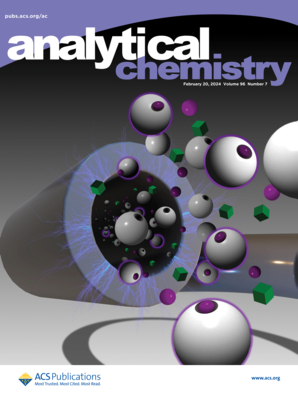Spectral Analysis for Photon Emission of Rare-Earth Ions in Single Plasmonic Hot Spot
IF 6.7
1区 化学
Q1 CHEMISTRY, ANALYTICAL
引用次数: 0
Abstract
Rare earth ion luminescent materials have attracted extensive attention due to their wide applications in biochemical sensing and bioimaging. However, the low quantum yield and weak luminescence intensity have restricted their further development. Realizing the modulation of rare-earth ions’ emission behavior has become a hot topic in the interdisciplinary fields of materials and chemometrics. Herein, the regulation of the electron decay process and emission of photon signals of rare earth ion (Eu3+) has been achieved in a well-defined plasmonic nanocavity. This nanocavity consists of Ag shell-isolated nanoparticles (SHINs) and an ultraflat Au film, which are separated by a polymer dielectric spacer and CaF2:Eu3+ nanoparticles. Contrary to the intrinsic photoluminescence of CaF2:Eu3+, a factor of 408 increase in the spontaneous emission rate and simultaneously an 800-fold enhancement in the emission intensity have been realized in nanocavities via comprehensive spectroscopic analysis. Additionally, the evolution law between the plasmon resonances and the luminescent enhancement as well as the emission spectrum of Eu3+ indicates a highly effective modulation of emission behavior by plasmons. This presents a novel strategy for enhancing the performance of optical micro- and nanodevices based on rare-earth ion materials, demonstrating significant potential in applications such as bioimaging and surface detection analysis.

求助全文
约1分钟内获得全文
求助全文
来源期刊

Analytical Chemistry
化学-分析化学
CiteScore
12.10
自引率
12.20%
发文量
1949
审稿时长
1.4 months
期刊介绍:
Analytical Chemistry, a peer-reviewed research journal, focuses on disseminating new and original knowledge across all branches of analytical chemistry. Fundamental articles may explore general principles of chemical measurement science and need not directly address existing or potential analytical methodology. They can be entirely theoretical or report experimental results. Contributions may cover various phases of analytical operations, including sampling, bioanalysis, electrochemistry, mass spectrometry, microscale and nanoscale systems, environmental analysis, separations, spectroscopy, chemical reactions and selectivity, instrumentation, imaging, surface analysis, and data processing. Papers discussing known analytical methods should present a significant, original application of the method, a notable improvement, or results on an important analyte.
 求助内容:
求助内容: 应助结果提醒方式:
应助结果提醒方式:


